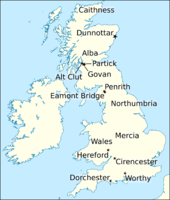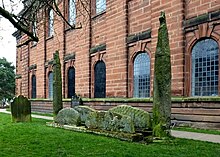Causantín mac Áeda was an early King of Scotland, known then by the Gaelic name Alba. The Kingdom of Alba, a name which first appears in Constantine's lifetime, was situated in modern-day Northern Scotland.
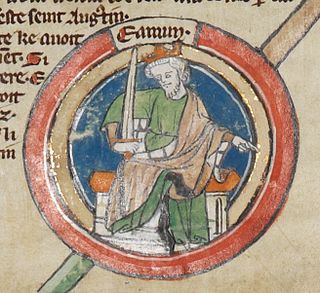
Edmund I or Eadmund I was King of the English from 27 October 939 until his death. He was the elder son of King Edward the Elder and his third wife, Queen Eadgifu, and a grandson of King Alfred the Great. After Edward died in 924, he was succeeded by his eldest son, Edmund's half-brother Æthelstan. Edmund was crowned after Æthelstan died childless in 939. He had two sons, Eadwig and Edgar, by his first wife Ælfgifu, and none by his second wife Æthelflæd. His sons were young children when he was killed in a brawl with an outlaw at Pucklechurch in Gloucestershire, and he was succeeded by his younger brother Eadred, who died in 955 and was followed by Edmund's sons in succession.

Æthelstan or Athelstan was King of the Anglo-Saxons from 924 to 927 and King of the English from 927 to his death in 939. He was the son of King Edward the Elder and his first wife, Ecgwynn. Modern historians regard him as the first King of England and one of the "greatest Anglo-Saxon kings". He never married and had no children; he was succeeded by his half-brother, Edmund I.
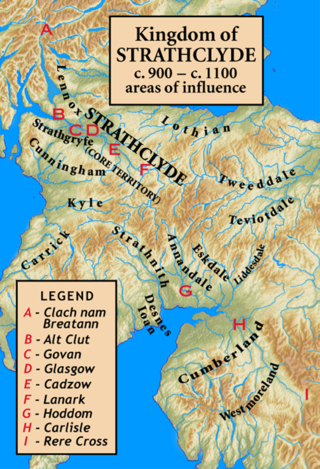
Strathclyde, was a Brittonic successor state of the Roman Empire and one of the early medieval kingdoms of the Britons, located in the region the Welsh tribes referred to as Yr Hen Ogledd, which comprised the Brythonic-speaking parts of what is now southern Scotland and northern England. The kingdom developed during Britain's post-Roman period. It is also known as Alt Clut, a Brittonic term for Dumbarton Castle, the medieval capital of the region. It may have had its origins with the Damnonii people of Ptolemy's Geography.
Cuilén was an early King of Alba (Scotland). He was a son of Illulb mac Custantín, King of Alba, after whom he is known by the patronymic mac Illuilb of Clann Áeda meic Cináeda, a branch of the Alpínid dynasty. During the 10th century, the Alpínids rotated the kingship of Alba between two main dynastic branches. Dub mac Maíl Choluim, a member of a rival branch of the kindred, seems to have succeeded after Illulb's death in 962. Cuilén soon after challenged him but was defeated in 965. Dub was eventually expelled and slain in 966/967. Whether Cuilén was responsible for his death is uncertain.

Eochaid was a ninth-century Briton who may have ruled as King of Strathclyde and/or King of the Picts. He was a son of Rhun ab Arthgal, King of Strathclyde, and descended from a long line of British kings. Eochaid's mother is recorded to have been a daughter of Cináed mac Ailpín, King of the Picts. This maternal descent from the royal Alpínid dynasty may well account for the record of Eochaid reigning over the Pictish realm after the death of Cináed's son, Áed, in 878. According to various sources, Áed was slain by Giric, a man of uncertain ancestry, who is also accorded kingship after Áed's demise.
Suibne mac Cináeda was an eleventh-century ruler of the Gall Gaidheil, a population of mixed Scandinavian and Gaelic ethnicity. There is little known of Suibne as he is only attested in three sources that record the year of his death. He seems to have ruled in a region where Gall Gaidheil are known to have dwelt: either the Hebrides, the Firth of Clyde region, or somewhere along the south-western coast of Scotland from the Firth of Clyde southwards into Galloway.
Arthgal ap Dyfnwal was a ninth-century king of Alt Clut. He descended from a long line of rulers of the British Kingdom of Alt Clut. Either he or his father, Dyfnwal ap Rhydderch, King of Alt Clut, may have reigned when the Britons are recorded to have burned the Pictish ecclesiastical site of Dunblane in 849.

Rhun ab Arthgal was a ninth-century King of Strathclyde. He is the only known son of Arthgal ap Dyfnwal, King of Alt Clut. In 870, during the latter's reign, the fortress of Alt Clut was captured by Vikings, after which Arthgal and his family may have been amongst the mass of prisoners taken back to Ireland. Two years later Arthgal is recorded to have been slain at the behest of Causantín mac Cináeda, King of the Picts. The circumstances surrounding this regicide are unknown. The fact that Rhun seems to have been Causantín's brother-in-law could account for Causantín's interference in the kingship of Alt Clut.
Dyfnwal was King of Strathclyde. Although his parentage is unknown, he was probably a member of the Cumbrian dynasty that is recorded to have ruled the Kingdom of Strathclyde immediately before him. Dyfnwal is attested by only one source, a mediaeval chronicle that places his death between the years 908 and 915.
Dyfnwal ab Owain was a tenth-century King of Strathclyde. He was a son of Owain ap Dyfnwal, King of Strathclyde, and seems to have been a member of the royal dynasty of Strathclyde. At some point in the ninth- or tenth century, the Kingdom of Strathclyde expanded substantially southwards. As a result of this extension far beyond the valley of the River Clyde, the realm became known as the Kingdom of Cumbria. By 927, the kingdom seems to have reached as far south as the River Eamont.

Rhydderch ap Dyfnwal was an eminent tenth-century Cumbrian who slew Cuilén mac Illuilb, King of Alba in 971. Rhydderch was possibly a son of Dyfnwal ab Owain, King of Strathclyde, and could have ruled as King of Strathclyde. Rhydderch appears on record in about 971, when he is said to have killed Cuilén mac Illuilb, King of Alba, a man said to have abducted and raped Rhydderch's daughter. Following Cuilén's death, the Cumbrian Kingdom of Strathclyde endured an invasion by Cuilén's successor, Cináed mac Maíl Choluim, King of Alba. This Scottish attack could have been a retaliatory raid for Rhydderch's actions, and may have been undertaken in the context of restoring Scottish authority over the Cumbrian realm. If Rhydderch ever ruled as king it must have been before 973, when Dyfnwal's son, Máel Coluim, is accorded the title king.
Máel Coluim was a tenth-century King of Strathclyde. He was a younger son of Dyfnwal ab Owain, King of Strathclyde, and thus a member of the Cumbrian dynasty that had ruled the kingdom for generations. Máel Coluim's Gaelic name could indicate that he was born during either an era of amiable relations with the Scots, or else during a period of Scottish overlordship. In 945, the Edmund I, King of the English invaded the kingdom, and appears to have granted the Scots permission to dominate the Cumbrians. The English king is further reported to have blinded several of Máel Coluim's brothers in an act that could have been an attempt to deprive Dyfnwal of an heir.

Owain Foel, also known as Owain Moel, Owain the Bald, Owen the Bald, and Eugenius Calvus, was an eleventh-century King of Strathclyde. He may have been a son of Máel Coluim, son of Dyfnwal ab Owain, two other rulers of the Kingdom of Strathclyde. Owain Foel is recorded to have supported the Scots at the Battle of Carham in 1018. Although it is possible that he died in the conflict, no source states as much, and it is uncertain when he died. Owain Foel may be an ancestor—perhaps the father—of a certain Máel Coluim who is described as the "son of the king of the Cumbrians" in the 1050s.
Amlaíb mac Illuilb was a tenth-century King of Alba. He was one of three sons of Illulb mac Custantín, King of Alba, and a member of Clann Áeda meic Cináeda, a branch of the Alpínid dynasty. Amlaíb's paternal grandfather possessed strong connections with the Scandinavian dynasty of Dublin, and there is evidence to suggest that Illulb and Amlaíb bore names of Old Norse origin. If Amlaíb's name indeed represents a Gaelicised Scandinavian name, it could indicate that his mother was a member of the Uí Ímair, and possibly a granddaughter of Amlaíb Cúarán or Amlaíb mac Gofraid.
Maccus mac Arailt, or Maccus Haraldsson, was a tenth-century King of the Isles. Although his parentage is uncertain, surviving evidence suggests that he was the son of Harald Sigtryggson, also known as Aralt mac Sitriuc, the Hiberno-Norse King of Limerick. Maccus' family is known as the Meic Arailt kindred. He and his brother, Gofraid, are first recorded in the 970s. It was during this decade and the next that they conducted military operations against the Welsh of Anglesey, apparently taking advantage of dynastic strife within the Kingdom of Gwynedd.
Ragnall mac Gofraid was King of the Isles and likely a member of the Uí Ímair kindred. He was a son of Gofraid mac Arailt, King of the Isles. Ragnall and Gofraid flourished at a time when the Kingdom of the Isles seems to have suffered from Orcadian encroachment at the hands of Sigurðr Hlǫðvisson, Earl of Orkney. Gofraid died in 989. Although Ragnall is accorded the kingship upon his own death in 1004 or 1005, the succession after his father's death is uncertain.
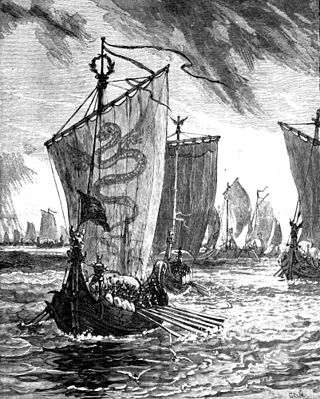
Gebeachan, also known as Gébennach, and Gebechán, was a tenth-century King of the Isles. He seems to have been a subordinate to Amlaíb mac Gofraid, King of Dublin, and is recorded to have fought and died at the Battle of Brunanburh in 937.
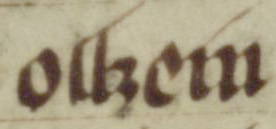
Owain ap Dyfnwal may have been an eleventh-century ruler of the Kingdom of Strathclyde. He seems to have been a son of Dyfnwal ab Owain, King of Strathclyde, and may well have succeeded Dyfnwal's son, Máel Coluim, King of Strathclyde. During Owain's reign, he would have faced a massive invasion by Æthelræd II, King of the English. Owain's death is recorded in 1015, and seems to have been succeeded by Owain Foel, a man who may have been his nephew.

Máel Coluim was an eleventh-century magnate who seems to have been established as either King of Alba or King of Strathclyde. In 1055, Siward, Earl of Northumbria defeated Mac Bethad mac Findlaích, the reigning ruler of the Kingdom of Alba. As a result of this military success against the Scots, several sources assert that Siward established Máel Coluim as king. It is uncertain whether this concerned the kingship of Alba or the kingship of Strathclyde.
